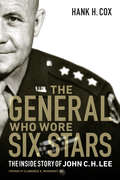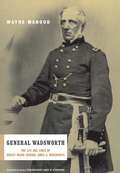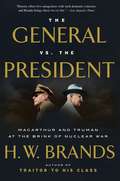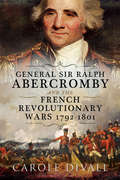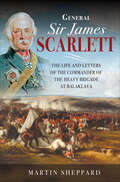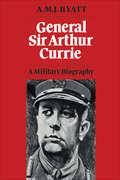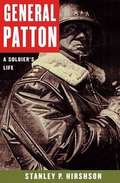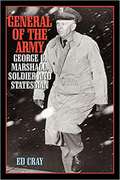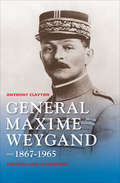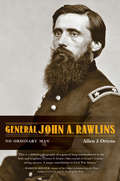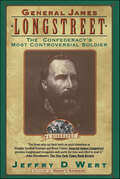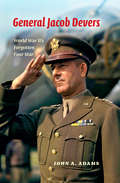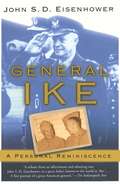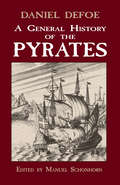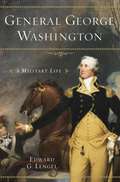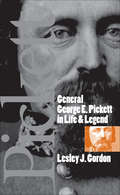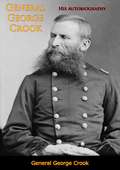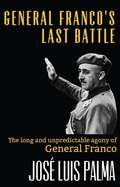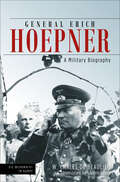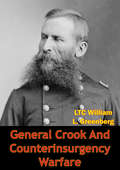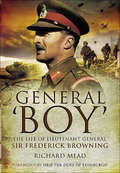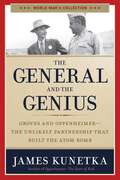- Table View
- List View
The General Who Wore Six Stars: The Inside Story of John C. H. Lee
by Hank H. Cox Clarence E. McKnight Jr.Lt. Gen. John C. H. Lee wore six stars on his helmet, three in front and three in back—an unusual affectation. He was a stickler for discipline and a legendary military figure whom servicemen and historians loved to hate. Yet Lee was an intensely religious person and an advocate of opportunity for African Americans in the era of Jim Crow, setting him apart from the conservative officer corps at this time. Lee was also responsible for supplying the Allied armies in Europe during World War II from D-Day through Germany’s surrender. In this long-overdue biography of the brilliant and eccentric commander, Hank H. Cox paints a vivid picture of this enormous logistical task and the man who made it all happen.The General Who Wore Six Stars delves into the perplexing details of how Lee let his idiosyncrasies get the better of him. This “pompous little son-of-a-bitch,” as some historians have called him, who was “only interested in self-advertisement,” famously moved his headquarters to Paris, where during the height of the American Army supply crisis, twenty-nine thousand of his Service of Supply troops shacked up in the finest hotels and, due to sheer numbers, created an enormous black market. Yet, Cox argues, Lee’s strategical genius throughout the war has been underappreciated not only by his contemporaries but also by World War II historians. The General Who Wore Six Stars provides a timely reassessment of this intriguing individual.
General Wadsworth: The Life and Times of Brevet Major General James S. Wadsworth
by Wayne MahoodJames S. Wadsworth was a successful lawyer and influential New York politician when the Civil War broke out. His wealth, strong anti-slavery views, and active support of President Lincoln made him a controversial public figure in the early war years. In 1863, he was given a field command and proved himself to be one of the Union's most able and daring commanders, although he died before the war ended. His battlefield boldness and righteous resolve to end slavery is, as former U. S. Congressman James W. Symington says, "a vivid reminder that our Civil War was, indeed, fought on moral grounds. "
The General vs. the President: MacArthur and Truman at the Brink of Nuclear War
by H. W. BrandsFrom master storyteller and historian H. W. Brands comes the riveting story of how President Harry Truman and General Douglas MacArthur squared off to decide America's future in the aftermath of World War II. At the height of the Korean War, President Harry S. Truman committed a gaffe that sent shock waves around the world. When asked by a reporter about the possible use of atomic weapons in response to China's entry into the war, Truman replied testily, "The military commander in the field will have charge of the use of the weapons, as he always has." This suggested that General Douglas MacArthur, the willful, fearless, and highly decorated commander of the American and U.N. forces, had his finger on the nuclear trigger. A correction quickly followed, but the damage was done; two visions for America's path forward were clearly in opposition, and one man would have to make way. Truman was one of the most unpopular presidents in American history. Heir to a struggling economy, a ruined Europe, and increasing tension with the Soviet Union, on no issue was the path ahead clear and easy. General MacArthur, by contrast, was incredibly popular, as untouchable as any officer has ever been in America. The lessons he drew from World War II were absolute: appeasement leads to disaster and a showdown with the communists was inevitable--the sooner the better. In the nuclear era, when the Soviets, too, had the bomb, the specter of a catastrophic third World War lurked menacingly close on the horizon. The contest of wills between these two titanic characters unfolds against the turbulent backdrop of a faraway war and terrors conjured at home by Joseph McCarthy. From the drama of Stalin's blockade of West Berlin to the daring landing of MacArthur's forces at Inchon to the shocking entrance of China into the war, The General and the President vividly evokes the making of a new American era.From the Hardcover edition.
General Sir Ralph Abercromby and the French Revolutionary Wars, 1792–1801
by Carole DivallThis biography of the Victorian era general and politician sheds light on Britain&’s military maneuverings against the First French Republic. The French Revolutionary Wars of 1793-1801 were a critical turning point in the political and diplomatic history of Europe, and Sir Ralph Abercromby played a leading role in the British military campaigns that were part of them. In this absorbing and perceptive study, Carole Divall throws new light onto Britain&’s position during the late eighteenth century, focusing on its military affairs and the expeditionary forces led by Abercromby during the conflict. After the convulsions of the French revolution, the tension between Britain and France only grew. British waged an economic war by attacking French colonial possessions, and money and men were sent to campaign on the continent. Abercromby was the most notable British general to exercise command of these expeditions, and his actions and experiences are central to the narrative. He led British forces during the disastrous campaign in Flanders, achieved some success in St Lucia and Trinidad, failed at Den Helder and finally triumphed in Egypt where he lost his life in 1801.
General Sir James Scarlett: The Life and Letters of the Commander of the Heavy Brigade at Balaklava
by Martin SheppardThe morning of the Battle of Balaklava, on 25 October 1854, saw a desperate charge against a greatly superior Russian force. Epitomised by the reckless courage of the British cavalry in the face of heavy odds, the charge was a complete success, putting the Russians to flight. This charge was not that of the Light Brigade, which took place later the same day, but that of the Heavy Brigade, under the command of General James Scarlett. Caught by surprise, Scarlett dressed the three hundred men nearest to him, placed himself well ahead of them and charged uphill to an extraordinary and unlikely victory. The Charge of the Heavy Brigade, a resounding success, has unjustly been overshadowed by the blunders that led to the heroic defeat of the Charge of the Light Brigade. James Scarlett himself has also been unfairly ignored due the focus on the enmity between the Earls of Cardigan and Lucan. The strategic significance of the Heavy Brigade’s victory, preventing the Russians capturing the key British base, the port of Balaklava, has been overlooked, as has General Scarlett’s decisive part in thwarting Russia’s best chance of winning the Crimean War. Although his heroic leadership at Balaklava was undoubtedly the most important event in James Scarlett’s life, he had a long and distinguished military career before and after the Crimean War. Based on his own previously unpublished letters, including a long description of his day at Balaklava, General Sir James Scarlett is the first book focused on a remarkable soldier.
General Sir Arthur Currie: A Military Biography (Canadian War Museum Historical Publication #no. 22)
by A.M.J. HyattThe most important Canadian in the First World War, Arthur Currie was an extraordinary successful field commander in a war that produced few successful generals. In this biography A.M.J. Hyatt recalls the military career of a remarkable man.<P><P> Currie's achievements were realized in spite of some formidable obstacles. He was not a professional soldier, having been a civilian before the war. He entered the war under the shadow of a scandal, which, had it been disclosed at the time, would certainly have brought public disgrace. He was not a charismatic man; he had none of the personal flair of so many successful military leaders. In many ways these apparently negative factors make his story all the more remarkable, the secret of his success the more intriguing. That secret, as Hyatt explains, was a fine sense of tactics: Currie, the 'amateur' soldier, had all the instincts of a dedicated professional, and he used them to minimize the destruction of the young Canadian troops under his command.<P> When the war was over Currie returned to civilian life, and was knighted for his service. This biography offers the first balanced account of a central figure in Canadian military history.
General Patton: A Soldier's Life
by Stanley P. Hirshson"War is my work and I know I sound sometimes as though I liked it; perhaps I do -- how can I tell? -- but this war hurts everybody. " -- Patton to Henry J. Taylor, 1945. General George S. Patton, Jr. , an inspirational leader and outstanding tactician, has intrigued and confounded his biographers. Now, utilizing untapped archival materials in both the United States and England, government documents, family papers, and oral histories, Stanley P. Hirshson creates the most balanced portrait of Patton ever written. It reveals Patton as a complex soldier capable of brilliant military maneuvers but also of inspiring his troops with fiery speeches that resulted in horrendous acts, such as the massacres of Italian civilians, It explains Patton's belief in a soldiers Valhalla, connects the family's wealth to one of Americas bitterest labor strikes, and disputes the usual interpretation of Patton's relief from command of the Third Army. In investigating this complex man, Hirshson has uncovered surprising material about a series of civilian massacres in Sicily, about the two slapping incidents, about attempts to exploit Patton's diary after his death, and about Patton's relations with top Allied generals. Patton emerges as a soldier of great imagination and courage, and his military campaigns make for edge-of-the-seat reading. All the drama of Patton's life comes alive in this meticulously documented volume.
General of the Army: George C. Marshall, Soldier and Statesman
by Ed CrayAs the U.S. Army's Chief of Staff through World War II, George Catlett Marshall (1880-1959) organized the military mobilization of unprecedented numbers of Americans and decisively shaped the Allied strategy that defeated first Nazi Germany, then Imperial Japan. As President Truman's Secretary of State, and later as his Secretary of Defense during the Korean War, Marshall the statesman created the European Recovery Act (known as the Marshall Plan), made possible the Berlin Airlift, and was awarded the Nobel Peace Prize. This masterful biography brings the reader face to face with a genuine American hero.
General Maxime Weygand, 1867-1965: Fortune and Misfortune (Encounters)
by Anthony ClaytonThe career of the French general Maxime Weygand offers a fascinating glimpse into the perils and politics of military leadership and loyalty in the interwar years and after France's defeat in 1940. Of obscure birth, Weygand had an outstanding career during WWI as chief of staff for Marshal Foch and served France after the war in Poland and Syria before returning home. Alarmed by Nazi Germany's rearmament, Weygand locked horns with a political leadership skeptical of the growing military threat, leading to accusations that his desire for a strong army was anti-democratic. With German invaders again threatening Paris, Weygand argued for armistice rather than face certain military defeat. No friend of the newly-installed Vichy government, Weygand was soon shuffled off to North Africa, where he plotted the army's return to the Allied cause. After the German entry into Unoccupied France, Weygand was imprisoned. Released at war's end, he was rearrested on the orders of Charles de Gaulle and afterwards fought to restore his name. In this concise biography, Anthony Clayton traces the vertiginous changes in fortune of a soldier whose loyalty to France and to the French army was unwavering.
General John A. Rawlins: No Ordinary Man
by Allen J. OttensNo one succeeds alone, and Ulysses S. Grant was no exception. From the earliest days of the Civil War to the heights of Grant's power in the White House, John A. Rawlins was ever at Grant's side. Yet Rawlins's role in Grant's career is often overlooked, and he barely received mention in Grant's own two-volume Memoirs. General John A. Rawlins: No Ordinary Man by Allen J. Ottens is the first major biography of Rawlins in over a century and traces his rise to assistant adjutant general and ultimately Grant's secretary of war. Ottens presents the portrait of a man who teamed with Grant, who submerged his needs and ambition in the service of Grant, and who at times served as the doubter who questioned whether Grant possessed the background to tackle the great responsibilities of the job. Rawlins played a pivotal role in Grant's relatively small staff, acting as administrator, counselor, and defender of Grant's burgeoning popularity. Rawlins qualifies as a true patriot, a man devoted to the Union and devoted to Grant. His is the story of a man who persevered in wartime and during the tumultuous years of Reconstruction and who, despite a ravaging disease that would cut short his blossoming career, grew to become a proponent of the personal and citizenship rights of those formerly enslaved. General John A. Rawlins will prove to be a fascinating and essential read for all who have an interest in leadership, the Civil War, or Ulysses S. Grant.
General James Longstreet: The Confederacy's Most Controversial Soldier
by Jeffry D. WertGeneral James Longstreet fought in nearly every campaign of the Civil War, from Manassas (the first battle of Bull Run) to Antietam, Fredericksburg, Chickamauga, Gettysburg, and was present at the surrender at Appomattox. Yet, he was largely held to blame for the Confederacy's defeat at Gettysburg. General James Longstreet sheds new light on the controversial commander and the man Robert E. Lee called “my old war horse.”
General Jacob Devers: World War II's Forgotten Four Star
by John A. AdamsOf the leaders of the American Army in World War II, Jacob Devers is undoubtedly the "forgotten four star." Plucked from relative obscurity in the Canal Zone, Devers was one of four generals selected by General of the Army George Marshall in 1941 to assist him in preparing the Army for war. He quickly became known in Army circles for his "can do" attitude and remarkable ability to cut through red tape. Among other duties, he was instrumental in transforming Ft. Bragg, then a small Army post, into a major training facility. As head of the armored force, Devers contributed to the development of a faster, more heavily armored tank, equipped with a higher velocity gun that could stand up to the more powerful German tanks, and helped to turn American armor into an effective fighting force. In spring 1943, Devers replaced Dwight Eisenhower as commander of the European Theater of Operations, then was given command of the 6th Army Group that invaded the south of France and fought its way through France and Germany to the Austrian border. In the European campaign to defeat Hitler, Eisenhower had three subordinate army group commanders--British Field Marshall Bernard Montgomery, Omar S. Bradley, and Jacob Devers. The first two are well-known--here the third receives the attention he properly deserves.
The General in His Labyrinth
by Gabriel García Márquez Edith GrossmanTale about Simon Bolivar, the general who dreamed of freeing South America from Spain.
General Ike
by John EisenhowerJohn S.D. Eisenhower modestly explains General Ike as "a son's view of a great military leader -- highly intelligent, strong, forceful, kind, yet as human as the rest of us." It is that, and more: a portrait of the greatest Allied military leader of the Second World War, by the man who knew Ike best. General Ike is a book that John Eisenhower always knew he had to write, a tribute from an affectionate and admiring son to a great father. John chose to write about the "military Ike," as opposed to the "political Ike," because Ike cared far more about his career in uniform than about his time in the White House. A series of portraits of Ike's relations with soldiers and statesmen, from MacArthur to Patton to Montgomery to Churchill to de Gaulle, reveals the many facets of a talented, driven, headstrong, yet diplomatic leader. Taken together, they reveal a man who was brilliant, if flawed; naÏve at times in dealing with the public, yet who never lost his head when others around him were losing theirs. Above all, General Ike was a man who never let up in the relentless pursuit of the destruction of Hitler. Here for the first time are eyewitness stories of General Patton showing off during military exercises; of Ike on the verge of departing for Europe and assuming command of the Eastern Theater; of Churchill stewing and lobbying Ike in his "off hours." Faced with giant personalities such as these men and MacArthur, not to mention difficult allies such as de Gaulle and Montgomery, Ike nevertheless managed to pull together history's greatest invasion force and to face down a determined enemy from Normandy to the Bulge and beyond. John Eisenhower masterfully uses the backdrop of Ike's key battles to paint a portrait of his father and his relationships with the great men of his time. General Ike is a ringing and inspiring testament to a great man by an accomplished historian. It is also a personal portrait of a caring, if not always available, father by his admiring son. It is history at its best.
A General History of the Pyrates
by Daniel DefoeImmensely readable history by the author of Robinson Crusoe incorporates the author's celebrated flair for journalistic detail, and represents the major source of information about piracy in the early 18th century. Defoe recounts the daring and bloody deeds of such outlaws as Edward Teach (alias Blackbeard), Captain Kidd, Mary Read, Anne Bonny, many others.
General He Yingqin
by Peter WorthingA revisionist study of the career of General He Yingqin, one of the most prominent military officers in China's Nationalist period (1928–1949) and one of the most misunderstood figures in twentieth-century China. Western scholars have dismissed He Yingqin as corrupt and incompetent, yet the Chinese archives reveal that he demonstrated considerable success as a combat commander and military administrator during civil conflicts and the Sino-Japanese War. His work in the Chinese Nationalist military served as the foundation of a close personal and professional relationship with Chiang Kai-shek, with whom he worked closely for more than two decades. Against the backdrop of the Nationalist revolution of the 1920s through the 1940s, Peter Worthing analyzes He Yingqin's rise to power alongside Chiang Kai-shek, his work in building the Nationalist military, and his fundamental role in carrying out policies designed to overcome the regime's greatest obstacles during this turbulent period of Chinese history.
General George Washington
by Edward G. LengelMuch has been written in the past two centuries about George Washington the statesman and "father of his country." Less often discussed is Washington's military career, including his exploits as a young officer and his performance as the Revolutionary War commander in chief. Now, in a revealing work of historical biography, Edward Lengel has written the definitive account of George Washington the soldier.Based largely on Washington's personal papers, this engrossing book paints a vivid, factual portrait of a man to whom lore and legend so tenaciously cling. To Lengel, Washington was the imperfect commander. Washington possessed no great tactical ingenuity, and his acknowledged "brilliance in retreat" only demonstrates the role luck plays in the fortunes of all great men. He was not an enlisted man's leader; he made a point of never mingling with his troops. He was not an especially creative military thinker; he fought largely by the book. He was not a professional, but a citizen soldier, who, at a time when warfare demanded that armies maneuver efficiently in precise formation, had little practical training handling men in combat. Yet despite his flaws, Washington was a remarkable figure, a true man of the moment, a leader who possessed a clear strategic, national, and continental vision, and who inspired complete loyalty from his fellow revolutionaries, officers, and enlisted men. America could never have won freedom without him.A trained surveyor, Washington mastered topography and used his superior knowledge of battlegrounds to maximum effect. He appreciated the importance of good allies in times of crisis, and understood well the benefits of coordination of ground and naval forces. Like the American nation itself, he was a whole that was greater than the sum of its parts-a remarkable everyman whose acts determined the course of history. Lengel argues that Washington's excellence was in his completeness, in how he united the military, political, and personal skills necessary to lead a nation in war and peace. At once informative and engaging, and filled with some eye-opening revelations about Washington, the war for American independence, and the very nature of military command, General George Washington is a book that reintroduces readers to a figure many think they already know.From the Hardcover edition.
General George Washington: A Military Life
by Edward G. Lengel“The most comprehensive and authoritative study of Washington’s military career ever written. ” –Joseph J. Ellis, author of His Excellency: George Washington Based largely on George Washington’s personal papers, this engrossing book paints a vivid, factual portrait of Washington the soldier. An expert in military history, Edward Lengel demonstrates that the “secret” to Washington’s excellence lay in his completeness, in how he united the military, political, and personal skills necessary to lead a nat...
General George E. Pickett in Life and Legend
by Lesley J. GordonThe man who gave his name to the greatest failed frontal attack in American military history, George E. Pickett is among the most famous Confederate generals of the Civil War. But even today he remains imperfectly understood, a figure shrouded in Lost Cause mythology. In this carefully researched biography, Lesley Gordon moves beyond earlier studies of Pickett. By investigating the central role played by his wife LaSalle in controlling his historical image, Gordon illuminates Pickett's legend as well as his life. After exploring Pickett's prewar life as a professional army officer trained at West Point, battle-tested in Mexico, and seasoned on the western frontier, Gordon traces his return to the South in 1861 to fight for the Confederacy. She examines his experiences during the Civil War, including the famed, but failed, charge at the battle of Gettysburg, and charts the decline in his career that followed. Gordon also looks at Pickett's marriage in 1863 to LaSalle Corbell, like him a child of the Virginia planter elite. Though their life together lasted only twelve years, LaSalle spent her five decades of widowhood writing and speaking about her husband and his military career. Appointing herself Pickett's official biographer, she became a self-proclaimed authority on the war and the Old South. In fact, says Gordon, LaSalle carefully and deliberately created a favorable image of her husband that was at odds with the man she had married."Lesley Gordon's study of George E. Pickett explores the reality of the general's life as well as its romanticized version that survived through the generations. . . . Excellent military history informed by recent scholarship in social history, General George E. Pickett in Life and Legend provides a sophisticated analysis of one of the Civil War's most memorable figures."--Journal of Southern History"Insightful and judicious, sometimes unconventional, and combining a clear narrative thread with a persuasive analysis of available evidence, [this] biography is a convincing assessment of George Pickett's place in Confederate history, an intriguing examination of his--and LaSalle's--character and personality, and a valuable look at the Pickett of legend."--Civil War History"The novelty of this elegantly written book resides in the degree to which Gordon, rather than relying heavily on LaSalle, complaining about her, or both, as previous researchers have done, carefully sifts through her various accounts and separates fact from fiction--and suggests the truths that reside in fiction."--Journal of American HistoryThe man who gave his name to the greatest failed frontal attack in American military history, George E. Pickett is among the most famous Confederate generals of the Civil War. But even today he remains imperfectly understood, a figure shrouded in Lost Cause mythology. In this carefully researched biography, Lesley Gordon moves beyond earlier studies of Pickett. By investigating how Pickett's wife LaSalle, who outlived her husband by five decades, helped control his historical image, Gordon illuminates Pickett's legend as well as his life. -->
General George Crook: His Autobiography [Second Edition]
by Martin F. Schmitt Gen. George CrookGeneral George Crook spent his entire military career, with the exception of the Civil War years, on the frontier. Fighting the Indians, he earned the distinction of being the lowest-ranking West Point cadet ever to rise to the rank of major-general.Crook’s autobiography covers the period from his graduation from West Point in 1852 to June 18, 1876, the day after the famous Battle of the Rosebud. Editor Martin F. Schmitt has supplemented Crook’s life story with other material from the general’s diaries and letters and from contemporary newspapers.“When Red Cloud, the Sioux chief, heard of the death of his old antagonist, the Army officer they called Three Stars, he told a missionary, ‘He, at least, never lied to us.’ General Sherman called Crook the greatest Indian fighter and manager the Army ever had. Yet this man who was the most effective campaigner against the Indians had won their respect and trust. To understand why, you ought to read General George Crook: His Autobiography, edited and annotated by Martin F. Schmitt.”—Los Angeles Times“A story straightforward, accurate, and interesting, packed with detail and saturated with a strong western flavor....The importance of this book lies not merely in its considerable contribution to our knowledge of military history and to the intimate and sometimes trenchant remarks made by Crook about his colleagues, but more particularly in the revelation of the character and aims of the general himself.”—Chicago Tribune
General Franco's Last Battle: The long and unpredictable agony of General Franco
by José Luis Palma Isabelle ChaizeThe youngest member of the medical team that treated General Francisco Franco during his long final agony tells the story of the turbulent days between the 15th of October and the 20th of November 1975. This is a non-fiction novel of great literary and historical value. As the author says in the book, 'with the passage of time I have convinced myself that Franco died because of his own doctors. I think we exhausted him too much, gave him too many orders - for a hard person, for a dictator, it must be unbearable.'
General Erich Hoepner: A Military Biography (Die Wehrmacht im Kampf)
by Chales de BeaulieuWritten by Hoepner's chief of staff on the Eastern Front, this military biography of the German WWII general is available in English for the first time.This biography of Erich Hoepner was written by Walter Chales de Beaulieu, a general staff officer who fought alongside him. It examines his leadership of panzer formations in Poland in 1939, France in 1940, and Russia in 1941. Hoepner was one of the most competent tank commanders of World War II, playing a significant role in Germany’s early successes. As the commander of the XVI Panzer Corps in 1939, Hoepner carried out the main thrust towards Warsaw, reaching the outskirts of the city in only eight days. With the same formation, he fought the French Cavalry Corps in Belgium, partook in the encirclement of Allied forces near Dunkirk, and advanced southwards over the Weygand Line deep into French territory. In 1941, Hoepner became the commander of Panzer Group 4, the main attack formation for the advance on Leningrad. In this book, Walter Chales de Beaulieu provides insight into Erich Hoepner’s ability as a panzer commander, painting a picture of a man who was committed to the military profession.
General Crook And Counterinsurgency Warfare
by LTC William L. GreenbergThis thesis investigates the operational and tactical procedures in counterinsurgency warfare developed by General George Crook while commanding U.S. Army forces in southwest and the northern plains. This work includes a brief introduction of General Crook's career before and during the Civil War. The study examines the capabilities of the U.S. Army and its Apache and Sioux opponents during Indian campaigns, which Crook participated in. Inherent in the study is an in-depth examination of Crook's campaigns against the Apaches in the 1872-75, 1882-86, and against the Sioux and Cheyenne in 1876-77.This study concludes that General Crook, through trial and error, developed a distinct brand of operational and tactical procedures to conduct effective counterinsurgency warfare. Though lacking a coherent strategic national policy concerning the Indians, Crook was capable of successfully developing and executing a coherent counterinsurgency policy at the operational and tactical levels. This comprehensive program produced victories against his enemies in the field and an integrated acculturation policy for the Indians who resided on the reservation. Crook's use of Apache scouts and the pack mule train revolutionized the Army's ability to track down the insurgents and defeat them. His use of population controls coupled with economic development provided his Indian opponents an alternative way of life for their societies.
General Boy: The Life of Lieutenant General Sir Frederick Browning
by Richard MeadThis is the first biography of Boy Browning, whose name is inextricably linked with the creation and employment of Britains airborne forces in the Second World War. Commissioned into the Grenadier Guards, Browning served on the Western Front, earning a DSO during the Battle of Cambrai. As Adjutant at Sandhurst, he began the tradition of riding a horse up the steps at the end of the commissioning parade. Browning represented England and Great Britain as a hurdler at the 1928 Winter Olympics. In 1932 Browning married Daphne du Maurier, who was ten years younger and became one of the 20th centurys most enduring and popular novelists with titles such as Jamaica Inn and Rebecca. Browning commanded two brigades before being appointed to command 1 Airborne Division in 1941, later acting as Eisenhowers advisor on airborne warfare in the Mediterranean. In 1944 he commanded 1st Airborne Corps, which he took to Holland for Operation MARKET GARDEN that September. Allegedly coining the phrase a bridge too far, he has received much of the blame for the operations failure.In late 1944, Browning became Chief of Staff to Mountbatten. In 1948 he became Comptroller and Treasurer to Princess Elizabeth and Prince Philip and then Treasurer to the latter following the Queens accession. He was a close adviser to the Royal couple, who respected and valued his judgment.By this time, Boy and Daphne lived separate lives with Boy working at the Palace in London and Daphne reluctant to leave her beloved Cornwall although the marriage remained intact. Questions exist as to Daphnes sexuality and Boy had a succession of discrete mistresses. After a nervous breakdown probably due to marriage problems, he resigned in 1959 and retired to Cornwall. Browning died in March 1965.
The General and the Genius: Groves and Oppenheimer ? The Unlikely Partnership that Built the Atom Bomb
by James KunetkaTwo ambitious men. One historic mission. With a blinding flash in the New Mexico desert in the summer of 1945, the world was changed forever. The bomb that ushered in the atomic age was the product of one of history's most improbable partnerships. The General and the Genius reveals how two extraordinary men pulled off the greatest scientific feat of the twentieth century. Leslie Richard Groves of the Army Corps of Engineers, who had made his name by building the Pentagon in record time and under budget, was made overlord of the impossibly vast scientific enterprise known as the Manhattan Project. His mission: to beat the Nazis to the atomic bomb. So he turned to the nation's preeminent theoretical physicist, J. Robert Oppenheimer--the chain-smoking, martini-quaffing son of wealthy Jewish immigrants, whose background was riddled with communist associations--Groves's opposite in nearly every respect. In their three-year collaboration, the iron-willed general and the visionary scientist led a brilliant team in a secret mountaintop lab and built the fearsome weapons that ended the war but introduced the human race to unimaginable new terrors. And at the heart of this most momentous work of World War II is the story of two extraordinary men--the general and the genius.
